Ethiopian Airlines: Competitive Advantage and Strategy Report
VerifiedAdded on 2022/08/10
|17
|4094
|83
Report
AI Summary
This report provides a comprehensive analysis of Ethiopian Airlines (EA), examining its business model, external environment, and strategies for success. It begins with an introduction highlighting EA's achievements and its focus on connecting Africa. The report then delves into EA's business model, emphasizing its multi-hub strategy and its advantages over point-to-point models. A PESTLE analysis is conducted to assess the external environment, considering political, economic, social, technological, legal, and environmental factors. The report also explores the benefits of Porter's Five Forces model and identifies key elements of EA's culture. Finally, it offers recommendations for sustaining EA's operations, based on the findings of the case study, aiming to provide insights for the airline's continued growth and competitiveness in the African market. The report is a valuable resource for understanding EA's strategic approach and its position within the airline industry.
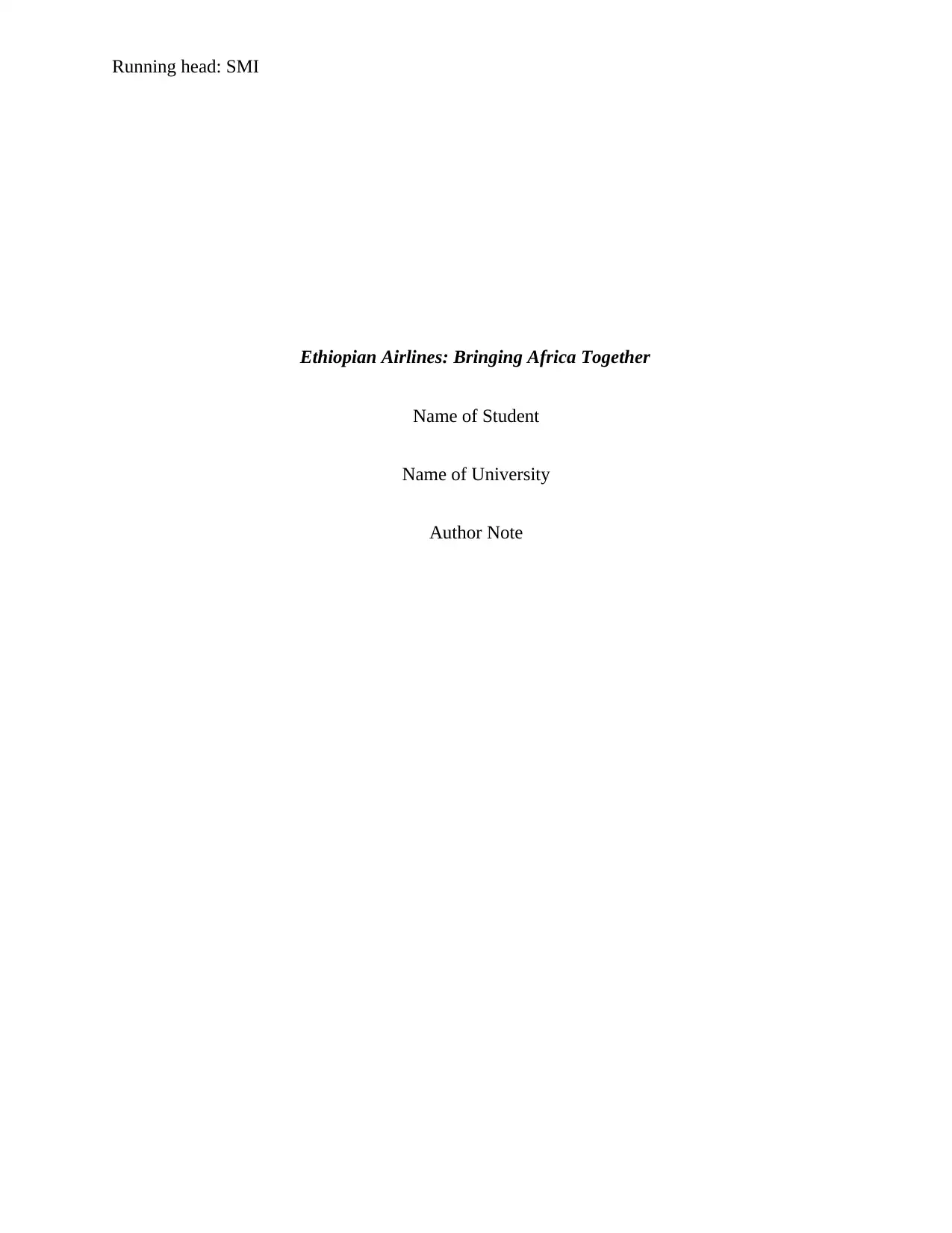
Running head: SMI
Ethiopian Airlines: Bringing Africa Together
Name of Student
Name of University
Author Note
Ethiopian Airlines: Bringing Africa Together
Name of Student
Name of University
Author Note
Paraphrase This Document
Need a fresh take? Get an instant paraphrase of this document with our AI Paraphraser
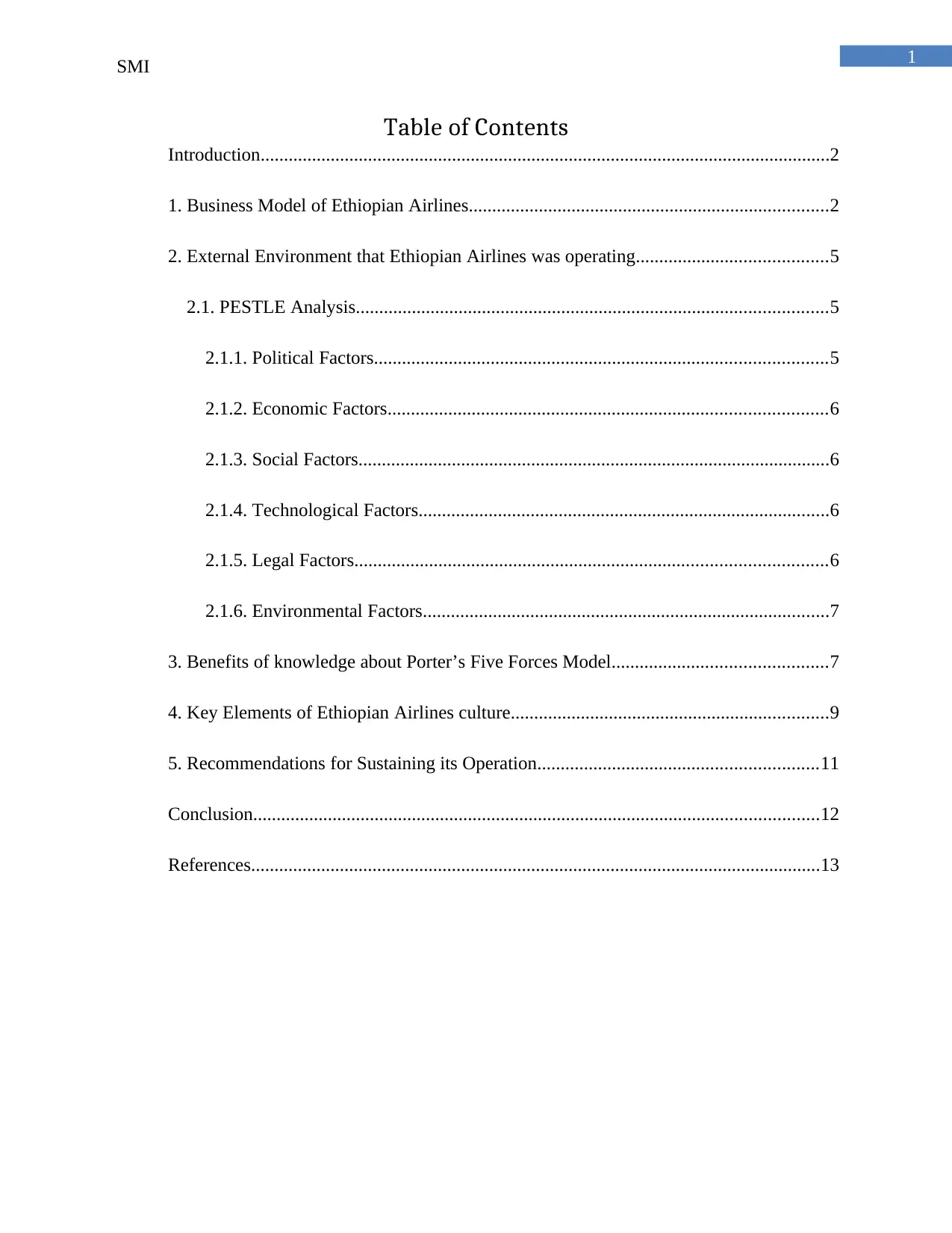
1
SMI
Table of Contents
Introduction..........................................................................................................................2
1. Business Model of Ethiopian Airlines.............................................................................2
2. External Environment that Ethiopian Airlines was operating.........................................5
2.1. PESTLE Analysis.....................................................................................................5
2.1.1. Political Factors.................................................................................................5
2.1.2. Economic Factors..............................................................................................6
2.1.3. Social Factors.....................................................................................................6
2.1.4. Technological Factors........................................................................................6
2.1.5. Legal Factors.....................................................................................................6
2.1.6. Environmental Factors.......................................................................................7
3. Benefits of knowledge about Porter’s Five Forces Model..............................................7
4. Key Elements of Ethiopian Airlines culture....................................................................9
5. Recommendations for Sustaining its Operation............................................................11
Conclusion.........................................................................................................................12
References..........................................................................................................................13
SMI
Table of Contents
Introduction..........................................................................................................................2
1. Business Model of Ethiopian Airlines.............................................................................2
2. External Environment that Ethiopian Airlines was operating.........................................5
2.1. PESTLE Analysis.....................................................................................................5
2.1.1. Political Factors.................................................................................................5
2.1.2. Economic Factors..............................................................................................6
2.1.3. Social Factors.....................................................................................................6
2.1.4. Technological Factors........................................................................................6
2.1.5. Legal Factors.....................................................................................................6
2.1.6. Environmental Factors.......................................................................................7
3. Benefits of knowledge about Porter’s Five Forces Model..............................................7
4. Key Elements of Ethiopian Airlines culture....................................................................9
5. Recommendations for Sustaining its Operation............................................................11
Conclusion.........................................................................................................................12
References..........................................................................................................................13
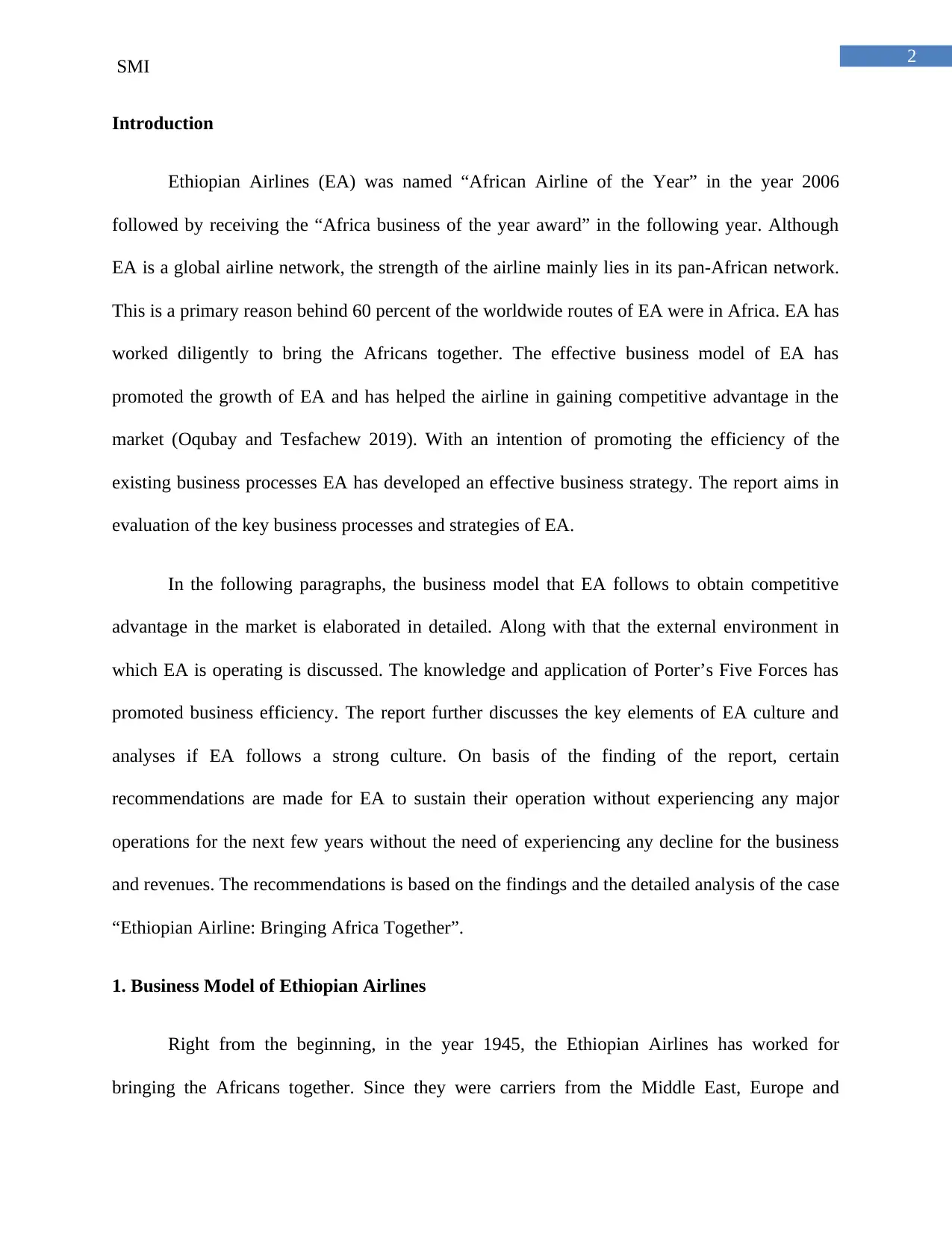
2
SMI
Introduction
Ethiopian Airlines (EA) was named “African Airline of the Year” in the year 2006
followed by receiving the “Africa business of the year award” in the following year. Although
EA is a global airline network, the strength of the airline mainly lies in its pan-African network.
This is a primary reason behind 60 percent of the worldwide routes of EA were in Africa. EA has
worked diligently to bring the Africans together. The effective business model of EA has
promoted the growth of EA and has helped the airline in gaining competitive advantage in the
market (Oqubay and Tesfachew 2019). With an intention of promoting the efficiency of the
existing business processes EA has developed an effective business strategy. The report aims in
evaluation of the key business processes and strategies of EA.
In the following paragraphs, the business model that EA follows to obtain competitive
advantage in the market is elaborated in detailed. Along with that the external environment in
which EA is operating is discussed. The knowledge and application of Porter’s Five Forces has
promoted business efficiency. The report further discusses the key elements of EA culture and
analyses if EA follows a strong culture. On basis of the finding of the report, certain
recommendations are made for EA to sustain their operation without experiencing any major
operations for the next few years without the need of experiencing any decline for the business
and revenues. The recommendations is based on the findings and the detailed analysis of the case
“Ethiopian Airline: Bringing Africa Together”.
1. Business Model of Ethiopian Airlines
Right from the beginning, in the year 1945, the Ethiopian Airlines has worked for
bringing the Africans together. Since they were carriers from the Middle East, Europe and
SMI
Introduction
Ethiopian Airlines (EA) was named “African Airline of the Year” in the year 2006
followed by receiving the “Africa business of the year award” in the following year. Although
EA is a global airline network, the strength of the airline mainly lies in its pan-African network.
This is a primary reason behind 60 percent of the worldwide routes of EA were in Africa. EA has
worked diligently to bring the Africans together. The effective business model of EA has
promoted the growth of EA and has helped the airline in gaining competitive advantage in the
market (Oqubay and Tesfachew 2019). With an intention of promoting the efficiency of the
existing business processes EA has developed an effective business strategy. The report aims in
evaluation of the key business processes and strategies of EA.
In the following paragraphs, the business model that EA follows to obtain competitive
advantage in the market is elaborated in detailed. Along with that the external environment in
which EA is operating is discussed. The knowledge and application of Porter’s Five Forces has
promoted business efficiency. The report further discusses the key elements of EA culture and
analyses if EA follows a strong culture. On basis of the finding of the report, certain
recommendations are made for EA to sustain their operation without experiencing any major
operations for the next few years without the need of experiencing any decline for the business
and revenues. The recommendations is based on the findings and the detailed analysis of the case
“Ethiopian Airline: Bringing Africa Together”.
1. Business Model of Ethiopian Airlines
Right from the beginning, in the year 1945, the Ethiopian Airlines has worked for
bringing the Africans together. Since they were carriers from the Middle East, Europe and
⊘ This is a preview!⊘
Do you want full access?
Subscribe today to unlock all pages.

Trusted by 1+ million students worldwide
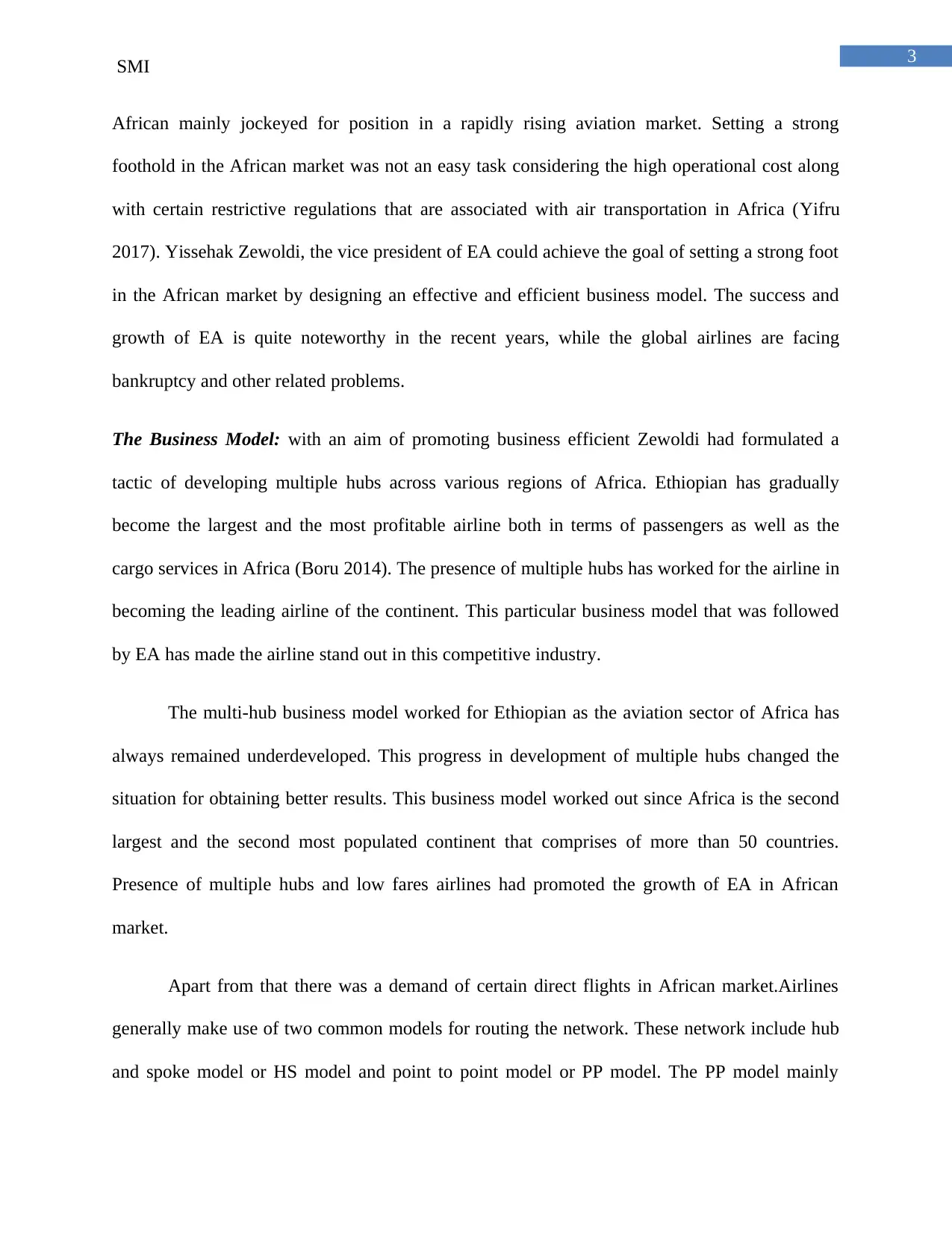
3
SMI
African mainly jockeyed for position in a rapidly rising aviation market. Setting a strong
foothold in the African market was not an easy task considering the high operational cost along
with certain restrictive regulations that are associated with air transportation in Africa (Yifru
2017). Yissehak Zewoldi, the vice president of EA could achieve the goal of setting a strong foot
in the African market by designing an effective and efficient business model. The success and
growth of EA is quite noteworthy in the recent years, while the global airlines are facing
bankruptcy and other related problems.
The Business Model: with an aim of promoting business efficient Zewoldi had formulated a
tactic of developing multiple hubs across various regions of Africa. Ethiopian has gradually
become the largest and the most profitable airline both in terms of passengers as well as the
cargo services in Africa (Boru 2014). The presence of multiple hubs has worked for the airline in
becoming the leading airline of the continent. This particular business model that was followed
by EA has made the airline stand out in this competitive industry.
The multi-hub business model worked for Ethiopian as the aviation sector of Africa has
always remained underdeveloped. This progress in development of multiple hubs changed the
situation for obtaining better results. This business model worked out since Africa is the second
largest and the second most populated continent that comprises of more than 50 countries.
Presence of multiple hubs and low fares airlines had promoted the growth of EA in African
market.
Apart from that there was a demand of certain direct flights in African market.Airlines
generally make use of two common models for routing the network. These network include hub
and spoke model or HS model and point to point model or PP model. The PP model mainly
SMI
African mainly jockeyed for position in a rapidly rising aviation market. Setting a strong
foothold in the African market was not an easy task considering the high operational cost along
with certain restrictive regulations that are associated with air transportation in Africa (Yifru
2017). Yissehak Zewoldi, the vice president of EA could achieve the goal of setting a strong foot
in the African market by designing an effective and efficient business model. The success and
growth of EA is quite noteworthy in the recent years, while the global airlines are facing
bankruptcy and other related problems.
The Business Model: with an aim of promoting business efficient Zewoldi had formulated a
tactic of developing multiple hubs across various regions of Africa. Ethiopian has gradually
become the largest and the most profitable airline both in terms of passengers as well as the
cargo services in Africa (Boru 2014). The presence of multiple hubs has worked for the airline in
becoming the leading airline of the continent. This particular business model that was followed
by EA has made the airline stand out in this competitive industry.
The multi-hub business model worked for Ethiopian as the aviation sector of Africa has
always remained underdeveloped. This progress in development of multiple hubs changed the
situation for obtaining better results. This business model worked out since Africa is the second
largest and the second most populated continent that comprises of more than 50 countries.
Presence of multiple hubs and low fares airlines had promoted the growth of EA in African
market.
Apart from that there was a demand of certain direct flights in African market.Airlines
generally make use of two common models for routing the network. These network include hub
and spoke model or HS model and point to point model or PP model. The PP model mainly
Paraphrase This Document
Need a fresh take? Get an instant paraphrase of this document with our AI Paraphraser
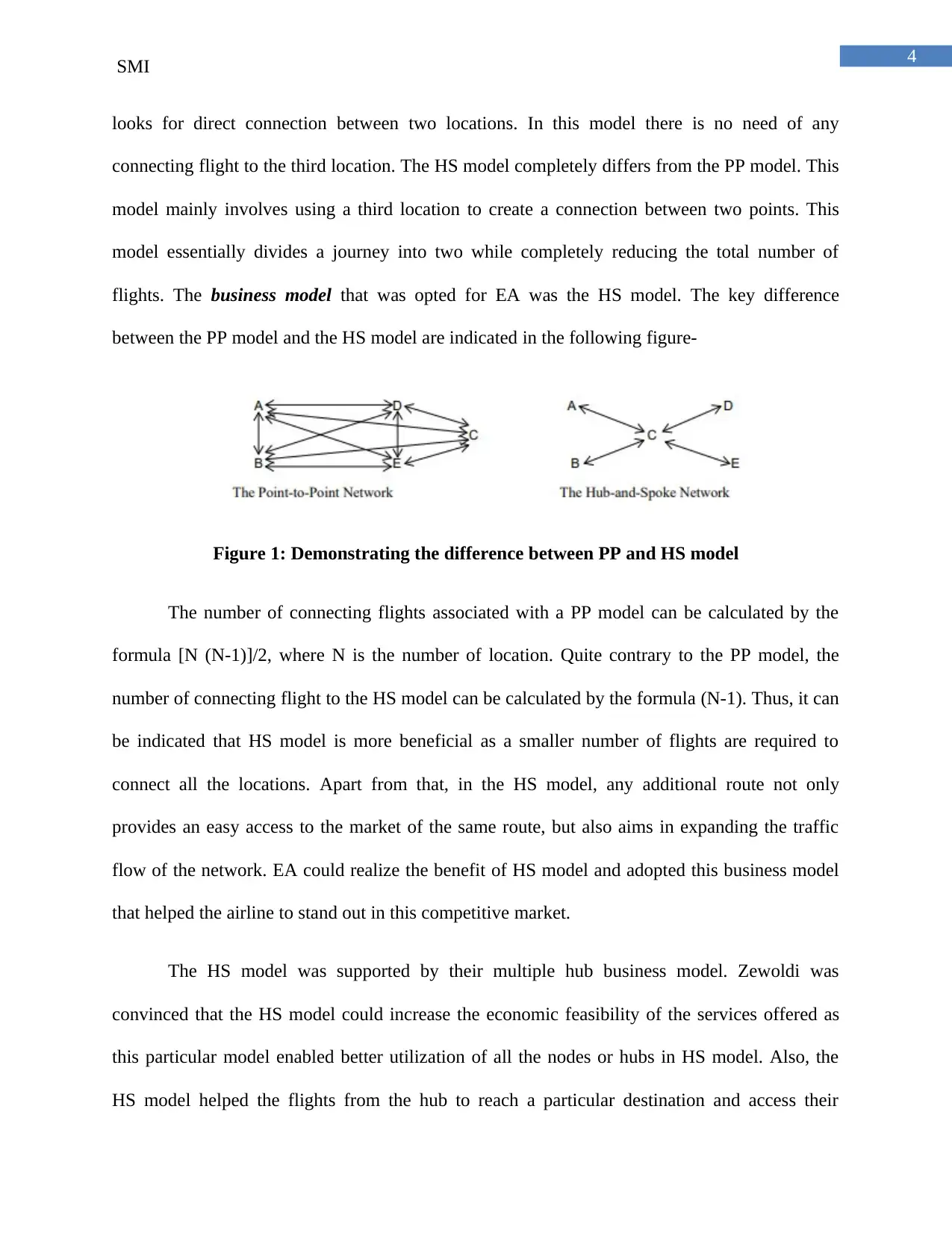
4
SMI
looks for direct connection between two locations. In this model there is no need of any
connecting flight to the third location. The HS model completely differs from the PP model. This
model mainly involves using a third location to create a connection between two points. This
model essentially divides a journey into two while completely reducing the total number of
flights. The business model that was opted for EA was the HS model. The key difference
between the PP model and the HS model are indicated in the following figure-
Figure 1: Demonstrating the difference between PP and HS model
The number of connecting flights associated with a PP model can be calculated by the
formula [N (N-1)]/2, where N is the number of location. Quite contrary to the PP model, the
number of connecting flight to the HS model can be calculated by the formula (N-1). Thus, it can
be indicated that HS model is more beneficial as a smaller number of flights are required to
connect all the locations. Apart from that, in the HS model, any additional route not only
provides an easy access to the market of the same route, but also aims in expanding the traffic
flow of the network. EA could realize the benefit of HS model and adopted this business model
that helped the airline to stand out in this competitive market.
The HS model was supported by their multiple hub business model. Zewoldi was
convinced that the HS model could increase the economic feasibility of the services offered as
this particular model enabled better utilization of all the nodes or hubs in HS model. Also, the
HS model helped the flights from the hub to reach a particular destination and access their
SMI
looks for direct connection between two locations. In this model there is no need of any
connecting flight to the third location. The HS model completely differs from the PP model. This
model mainly involves using a third location to create a connection between two points. This
model essentially divides a journey into two while completely reducing the total number of
flights. The business model that was opted for EA was the HS model. The key difference
between the PP model and the HS model are indicated in the following figure-
Figure 1: Demonstrating the difference between PP and HS model
The number of connecting flights associated with a PP model can be calculated by the
formula [N (N-1)]/2, where N is the number of location. Quite contrary to the PP model, the
number of connecting flight to the HS model can be calculated by the formula (N-1). Thus, it can
be indicated that HS model is more beneficial as a smaller number of flights are required to
connect all the locations. Apart from that, in the HS model, any additional route not only
provides an easy access to the market of the same route, but also aims in expanding the traffic
flow of the network. EA could realize the benefit of HS model and adopted this business model
that helped the airline to stand out in this competitive market.
The HS model was supported by their multiple hub business model. Zewoldi was
convinced that the HS model could increase the economic feasibility of the services offered as
this particular model enabled better utilization of all the nodes or hubs in HS model. Also, the
HS model helped the flights from the hub to reach a particular destination and access their
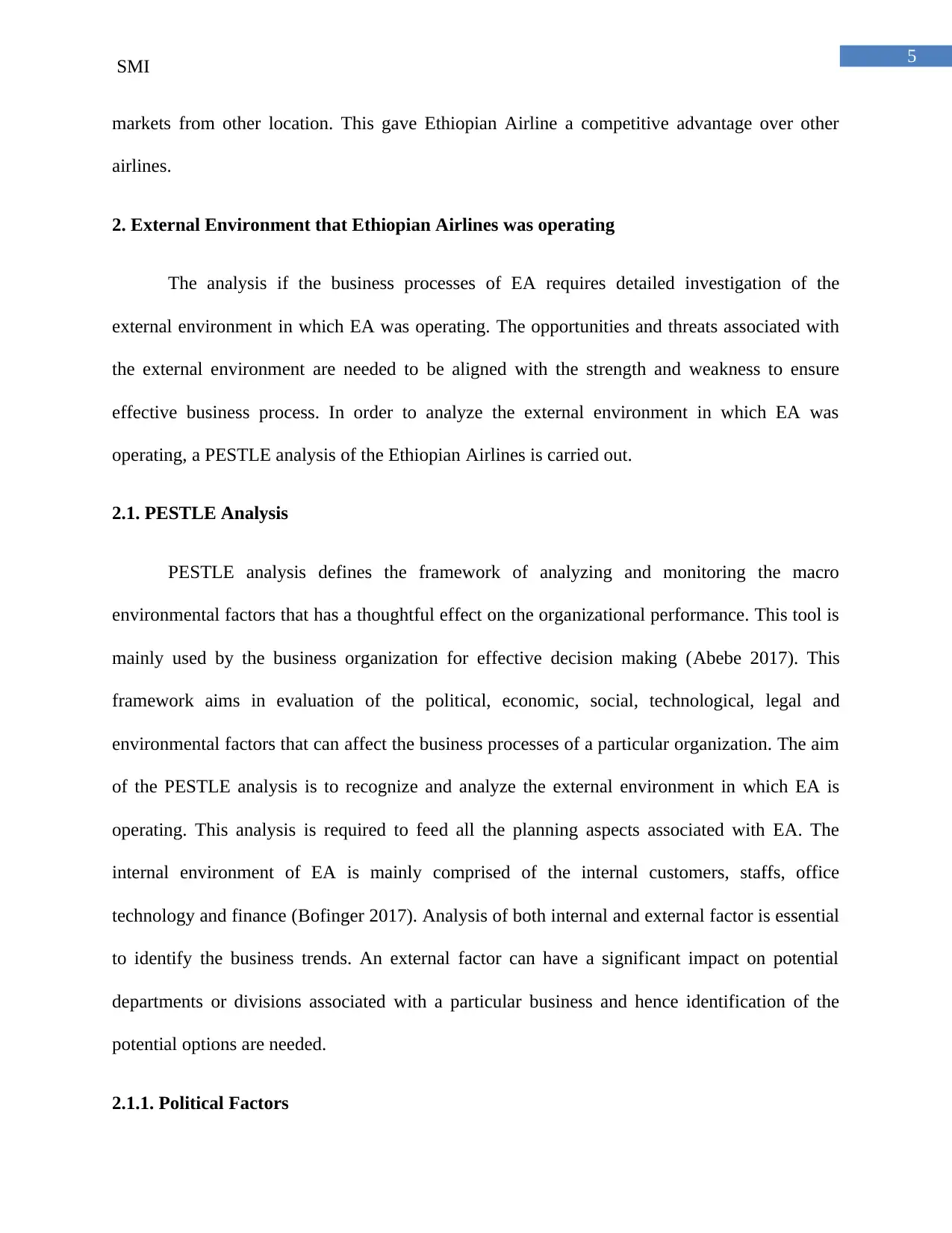
5
SMI
markets from other location. This gave Ethiopian Airline a competitive advantage over other
airlines.
2. External Environment that Ethiopian Airlines was operating
The analysis if the business processes of EA requires detailed investigation of the
external environment in which EA was operating. The opportunities and threats associated with
the external environment are needed to be aligned with the strength and weakness to ensure
effective business process. In order to analyze the external environment in which EA was
operating, a PESTLE analysis of the Ethiopian Airlines is carried out.
2.1. PESTLE Analysis
PESTLE analysis defines the framework of analyzing and monitoring the macro
environmental factors that has a thoughtful effect on the organizational performance. This tool is
mainly used by the business organization for effective decision making (Abebe 2017). This
framework aims in evaluation of the political, economic, social, technological, legal and
environmental factors that can affect the business processes of a particular organization. The aim
of the PESTLE analysis is to recognize and analyze the external environment in which EA is
operating. This analysis is required to feed all the planning aspects associated with EA. The
internal environment of EA is mainly comprised of the internal customers, staffs, office
technology and finance (Bofinger 2017). Analysis of both internal and external factor is essential
to identify the business trends. An external factor can have a significant impact on potential
departments or divisions associated with a particular business and hence identification of the
potential options are needed.
2.1.1. Political Factors
SMI
markets from other location. This gave Ethiopian Airline a competitive advantage over other
airlines.
2. External Environment that Ethiopian Airlines was operating
The analysis if the business processes of EA requires detailed investigation of the
external environment in which EA was operating. The opportunities and threats associated with
the external environment are needed to be aligned with the strength and weakness to ensure
effective business process. In order to analyze the external environment in which EA was
operating, a PESTLE analysis of the Ethiopian Airlines is carried out.
2.1. PESTLE Analysis
PESTLE analysis defines the framework of analyzing and monitoring the macro
environmental factors that has a thoughtful effect on the organizational performance. This tool is
mainly used by the business organization for effective decision making (Abebe 2017). This
framework aims in evaluation of the political, economic, social, technological, legal and
environmental factors that can affect the business processes of a particular organization. The aim
of the PESTLE analysis is to recognize and analyze the external environment in which EA is
operating. This analysis is required to feed all the planning aspects associated with EA. The
internal environment of EA is mainly comprised of the internal customers, staffs, office
technology and finance (Bofinger 2017). Analysis of both internal and external factor is essential
to identify the business trends. An external factor can have a significant impact on potential
departments or divisions associated with a particular business and hence identification of the
potential options are needed.
2.1.1. Political Factors
⊘ This is a preview!⊘
Do you want full access?
Subscribe today to unlock all pages.

Trusted by 1+ million students worldwide
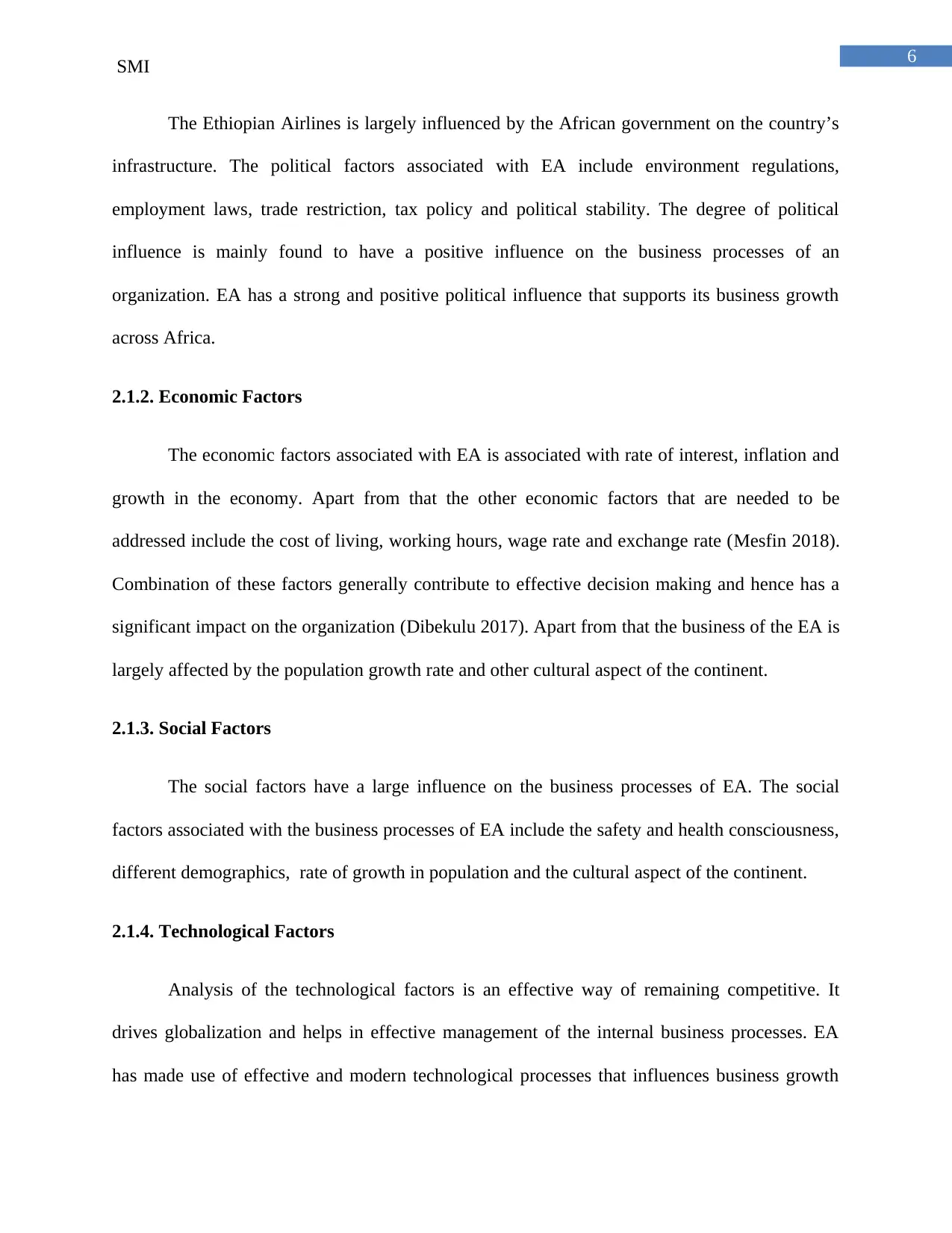
6
SMI
The Ethiopian Airlines is largely influenced by the African government on the country’s
infrastructure. The political factors associated with EA include environment regulations,
employment laws, trade restriction, tax policy and political stability. The degree of political
influence is mainly found to have a positive influence on the business processes of an
organization. EA has a strong and positive political influence that supports its business growth
across Africa.
2.1.2. Economic Factors
The economic factors associated with EA is associated with rate of interest, inflation and
growth in the economy. Apart from that the other economic factors that are needed to be
addressed include the cost of living, working hours, wage rate and exchange rate (Mesfin 2018).
Combination of these factors generally contribute to effective decision making and hence has a
significant impact on the organization (Dibekulu 2017). Apart from that the business of the EA is
largely affected by the population growth rate and other cultural aspect of the continent.
2.1.3. Social Factors
The social factors have a large influence on the business processes of EA. The social
factors associated with the business processes of EA include the safety and health consciousness,
different demographics, rate of growth in population and the cultural aspect of the continent.
2.1.4. Technological Factors
Analysis of the technological factors is an effective way of remaining competitive. It
drives globalization and helps in effective management of the internal business processes. EA
has made use of effective and modern technological processes that influences business growth
SMI
The Ethiopian Airlines is largely influenced by the African government on the country’s
infrastructure. The political factors associated with EA include environment regulations,
employment laws, trade restriction, tax policy and political stability. The degree of political
influence is mainly found to have a positive influence on the business processes of an
organization. EA has a strong and positive political influence that supports its business growth
across Africa.
2.1.2. Economic Factors
The economic factors associated with EA is associated with rate of interest, inflation and
growth in the economy. Apart from that the other economic factors that are needed to be
addressed include the cost of living, working hours, wage rate and exchange rate (Mesfin 2018).
Combination of these factors generally contribute to effective decision making and hence has a
significant impact on the organization (Dibekulu 2017). Apart from that the business of the EA is
largely affected by the population growth rate and other cultural aspect of the continent.
2.1.3. Social Factors
The social factors have a large influence on the business processes of EA. The social
factors associated with the business processes of EA include the safety and health consciousness,
different demographics, rate of growth in population and the cultural aspect of the continent.
2.1.4. Technological Factors
Analysis of the technological factors is an effective way of remaining competitive. It
drives globalization and helps in effective management of the internal business processes. EA
has made use of effective and modern technological processes that influences business growth
Paraphrase This Document
Need a fresh take? Get an instant paraphrase of this document with our AI Paraphraser
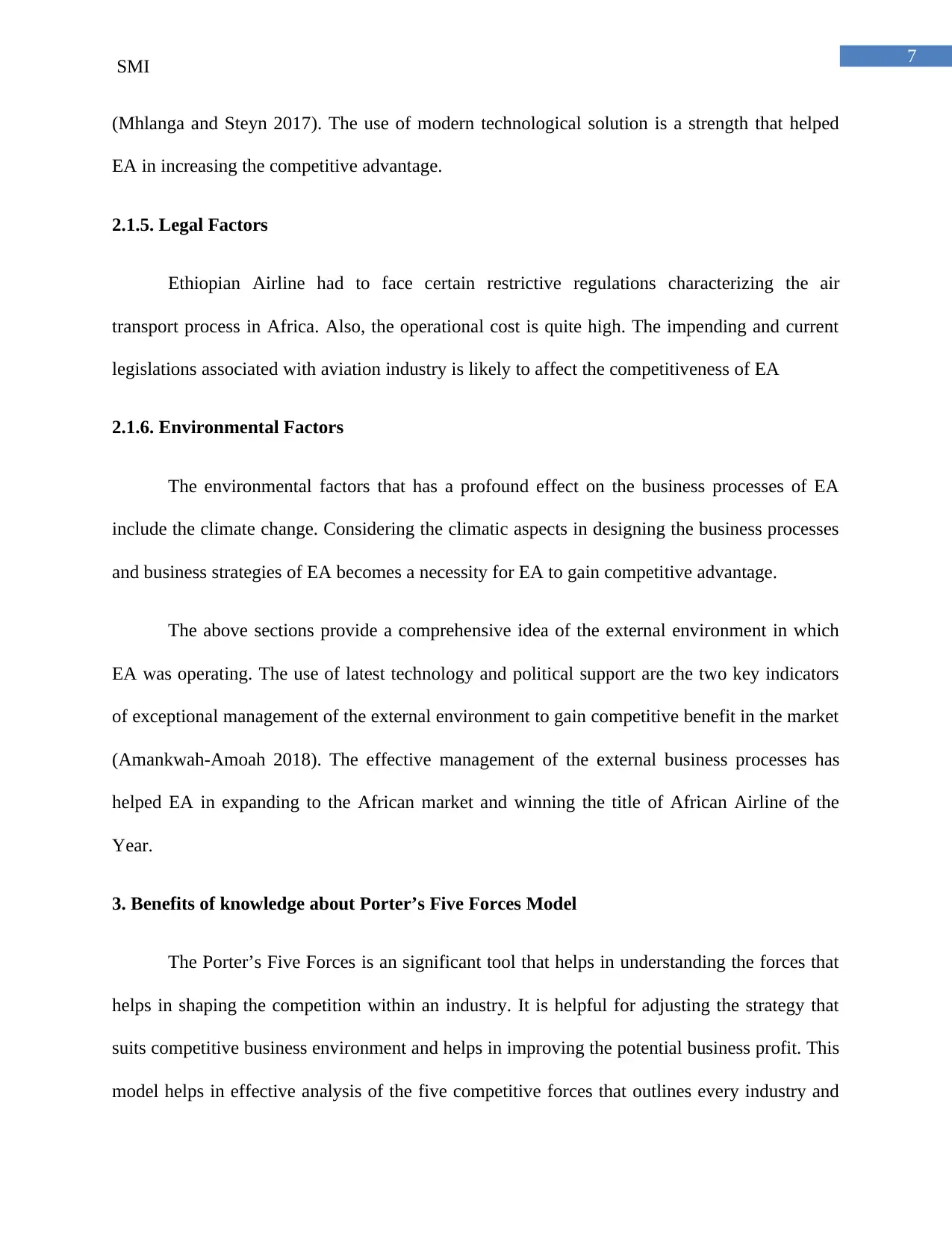
7
SMI
(Mhlanga and Steyn 2017). The use of modern technological solution is a strength that helped
EA in increasing the competitive advantage.
2.1.5. Legal Factors
Ethiopian Airline had to face certain restrictive regulations characterizing the air
transport process in Africa. Also, the operational cost is quite high. The impending and current
legislations associated with aviation industry is likely to affect the competitiveness of EA
2.1.6. Environmental Factors
The environmental factors that has a profound effect on the business processes of EA
include the climate change. Considering the climatic aspects in designing the business processes
and business strategies of EA becomes a necessity for EA to gain competitive advantage.
The above sections provide a comprehensive idea of the external environment in which
EA was operating. The use of latest technology and political support are the two key indicators
of exceptional management of the external environment to gain competitive benefit in the market
(Amankwah-Amoah 2018). The effective management of the external business processes has
helped EA in expanding to the African market and winning the title of African Airline of the
Year.
3. Benefits of knowledge about Porter’s Five Forces Model
The Porter’s Five Forces is an significant tool that helps in understanding the forces that
helps in shaping the competition within an industry. It is helpful for adjusting the strategy that
suits competitive business environment and helps in improving the potential business profit. This
model helps in effective analysis of the five competitive forces that outlines every industry and
SMI
(Mhlanga and Steyn 2017). The use of modern technological solution is a strength that helped
EA in increasing the competitive advantage.
2.1.5. Legal Factors
Ethiopian Airline had to face certain restrictive regulations characterizing the air
transport process in Africa. Also, the operational cost is quite high. The impending and current
legislations associated with aviation industry is likely to affect the competitiveness of EA
2.1.6. Environmental Factors
The environmental factors that has a profound effect on the business processes of EA
include the climate change. Considering the climatic aspects in designing the business processes
and business strategies of EA becomes a necessity for EA to gain competitive advantage.
The above sections provide a comprehensive idea of the external environment in which
EA was operating. The use of latest technology and political support are the two key indicators
of exceptional management of the external environment to gain competitive benefit in the market
(Amankwah-Amoah 2018). The effective management of the external business processes has
helped EA in expanding to the African market and winning the title of African Airline of the
Year.
3. Benefits of knowledge about Porter’s Five Forces Model
The Porter’s Five Forces is an significant tool that helps in understanding the forces that
helps in shaping the competition within an industry. It is helpful for adjusting the strategy that
suits competitive business environment and helps in improving the potential business profit. This
model helps in effective analysis of the five competitive forces that outlines every industry and
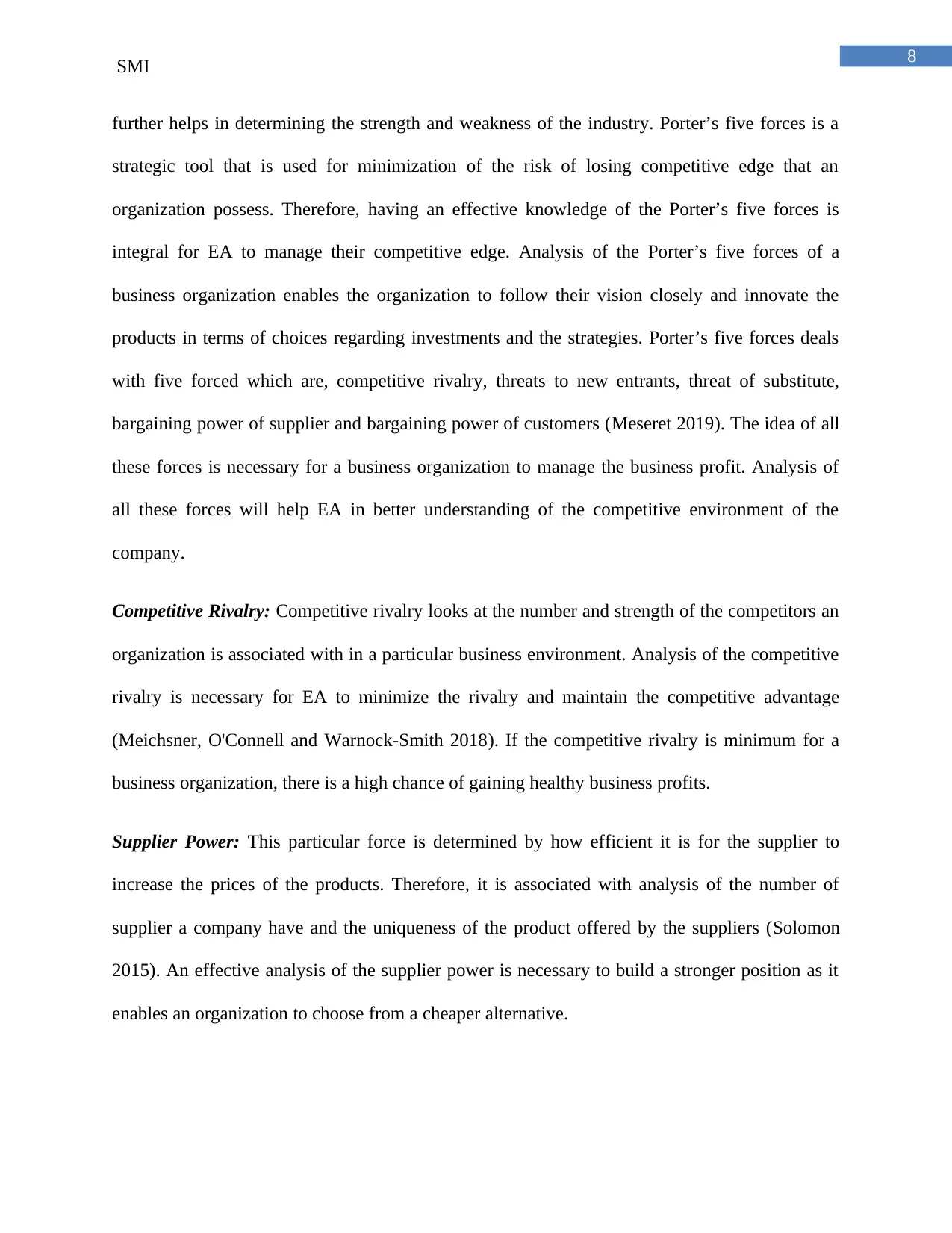
8
SMI
further helps in determining the strength and weakness of the industry. Porter’s five forces is a
strategic tool that is used for minimization of the risk of losing competitive edge that an
organization possess. Therefore, having an effective knowledge of the Porter’s five forces is
integral for EA to manage their competitive edge. Analysis of the Porter’s five forces of a
business organization enables the organization to follow their vision closely and innovate the
products in terms of choices regarding investments and the strategies. Porter’s five forces deals
with five forced which are, competitive rivalry, threats to new entrants, threat of substitute,
bargaining power of supplier and bargaining power of customers (Meseret 2019). The idea of all
these forces is necessary for a business organization to manage the business profit. Analysis of
all these forces will help EA in better understanding of the competitive environment of the
company.
Competitive Rivalry: Competitive rivalry looks at the number and strength of the competitors an
organization is associated with in a particular business environment. Analysis of the competitive
rivalry is necessary for EA to minimize the rivalry and maintain the competitive advantage
(Meichsner, O'Connell and Warnock-Smith 2018). If the competitive rivalry is minimum for a
business organization, there is a high chance of gaining healthy business profits.
Supplier Power: This particular force is determined by how efficient it is for the supplier to
increase the prices of the products. Therefore, it is associated with analysis of the number of
supplier a company have and the uniqueness of the product offered by the suppliers (Solomon
2015). An effective analysis of the supplier power is necessary to build a stronger position as it
enables an organization to choose from a cheaper alternative.
SMI
further helps in determining the strength and weakness of the industry. Porter’s five forces is a
strategic tool that is used for minimization of the risk of losing competitive edge that an
organization possess. Therefore, having an effective knowledge of the Porter’s five forces is
integral for EA to manage their competitive edge. Analysis of the Porter’s five forces of a
business organization enables the organization to follow their vision closely and innovate the
products in terms of choices regarding investments and the strategies. Porter’s five forces deals
with five forced which are, competitive rivalry, threats to new entrants, threat of substitute,
bargaining power of supplier and bargaining power of customers (Meseret 2019). The idea of all
these forces is necessary for a business organization to manage the business profit. Analysis of
all these forces will help EA in better understanding of the competitive environment of the
company.
Competitive Rivalry: Competitive rivalry looks at the number and strength of the competitors an
organization is associated with in a particular business environment. Analysis of the competitive
rivalry is necessary for EA to minimize the rivalry and maintain the competitive advantage
(Meichsner, O'Connell and Warnock-Smith 2018). If the competitive rivalry is minimum for a
business organization, there is a high chance of gaining healthy business profits.
Supplier Power: This particular force is determined by how efficient it is for the supplier to
increase the prices of the products. Therefore, it is associated with analysis of the number of
supplier a company have and the uniqueness of the product offered by the suppliers (Solomon
2015). An effective analysis of the supplier power is necessary to build a stronger position as it
enables an organization to choose from a cheaper alternative.
⊘ This is a preview!⊘
Do you want full access?
Subscribe today to unlock all pages.

Trusted by 1+ million students worldwide
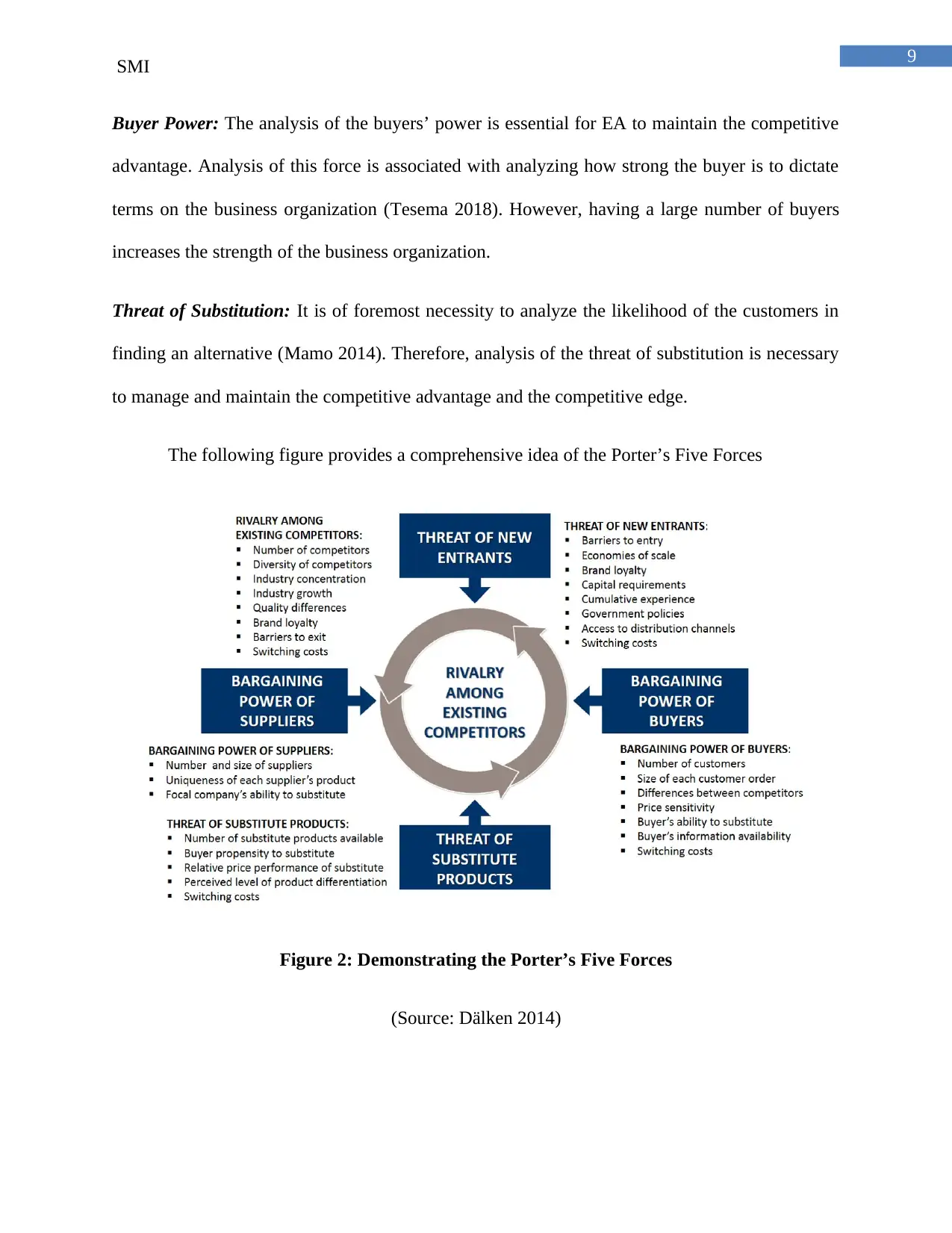
9
SMI
Buyer Power: The analysis of the buyers’ power is essential for EA to maintain the competitive
advantage. Analysis of this force is associated with analyzing how strong the buyer is to dictate
terms on the business organization (Tesema 2018). However, having a large number of buyers
increases the strength of the business organization.
Threat of Substitution: It is of foremost necessity to analyze the likelihood of the customers in
finding an alternative (Mamo 2014). Therefore, analysis of the threat of substitution is necessary
to manage and maintain the competitive advantage and the competitive edge.
The following figure provides a comprehensive idea of the Porter’s Five Forces
Figure 2: Demonstrating the Porter’s Five Forces
(Source: Dälken 2014)
SMI
Buyer Power: The analysis of the buyers’ power is essential for EA to maintain the competitive
advantage. Analysis of this force is associated with analyzing how strong the buyer is to dictate
terms on the business organization (Tesema 2018). However, having a large number of buyers
increases the strength of the business organization.
Threat of Substitution: It is of foremost necessity to analyze the likelihood of the customers in
finding an alternative (Mamo 2014). Therefore, analysis of the threat of substitution is necessary
to manage and maintain the competitive advantage and the competitive edge.
The following figure provides a comprehensive idea of the Porter’s Five Forces
Figure 2: Demonstrating the Porter’s Five Forces
(Source: Dälken 2014)
Paraphrase This Document
Need a fresh take? Get an instant paraphrase of this document with our AI Paraphraser
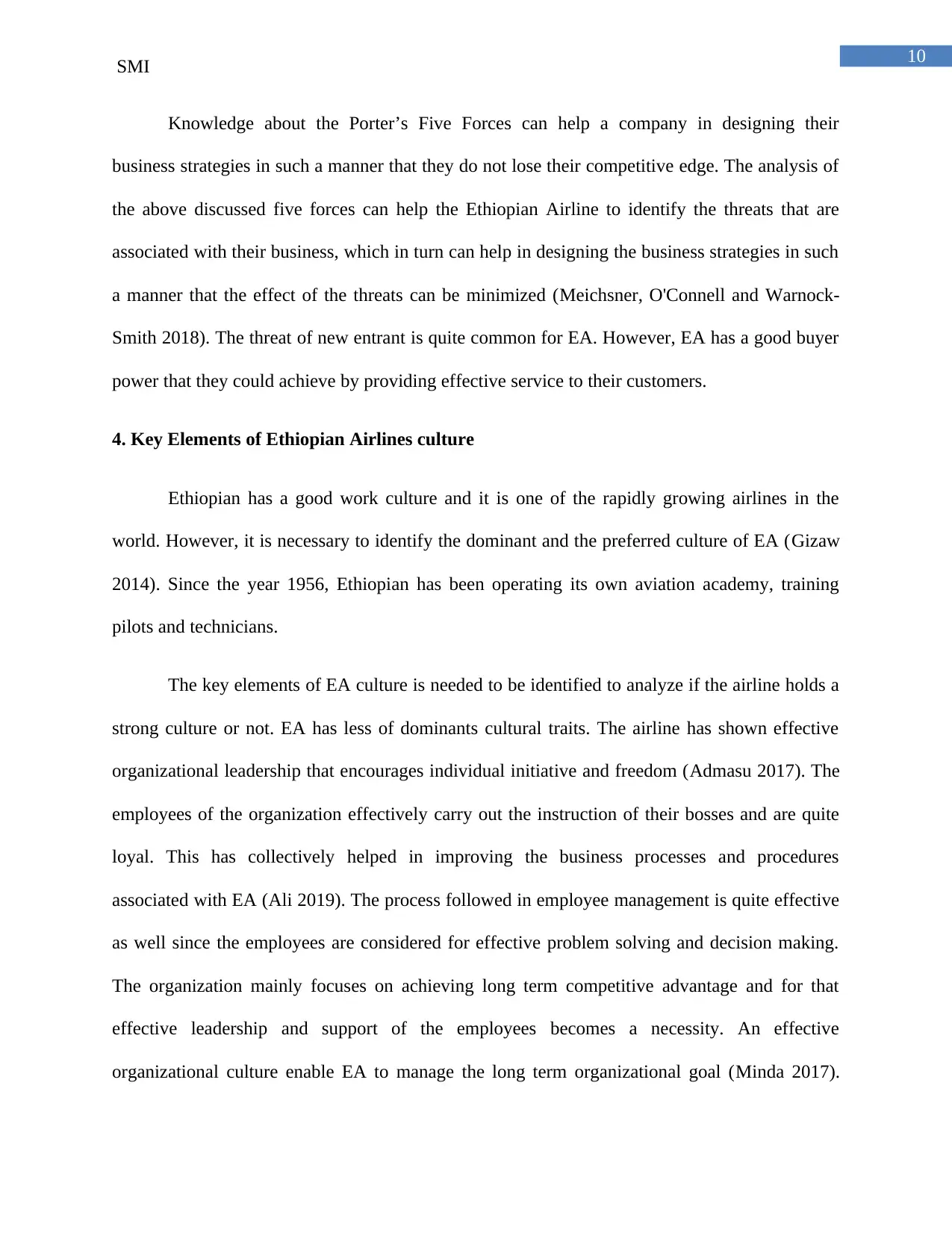
10
SMI
Knowledge about the Porter’s Five Forces can help a company in designing their
business strategies in such a manner that they do not lose their competitive edge. The analysis of
the above discussed five forces can help the Ethiopian Airline to identify the threats that are
associated with their business, which in turn can help in designing the business strategies in such
a manner that the effect of the threats can be minimized (Meichsner, O'Connell and Warnock-
Smith 2018). The threat of new entrant is quite common for EA. However, EA has a good buyer
power that they could achieve by providing effective service to their customers.
4. Key Elements of Ethiopian Airlines culture
Ethiopian has a good work culture and it is one of the rapidly growing airlines in the
world. However, it is necessary to identify the dominant and the preferred culture of EA (Gizaw
2014). Since the year 1956, Ethiopian has been operating its own aviation academy, training
pilots and technicians.
The key elements of EA culture is needed to be identified to analyze if the airline holds a
strong culture or not. EA has less of dominants cultural traits. The airline has shown effective
organizational leadership that encourages individual initiative and freedom (Admasu 2017). The
employees of the organization effectively carry out the instruction of their bosses and are quite
loyal. This has collectively helped in improving the business processes and procedures
associated with EA (Ali 2019). The process followed in employee management is quite effective
as well since the employees are considered for effective problem solving and decision making.
The organization mainly focuses on achieving long term competitive advantage and for that
effective leadership and support of the employees becomes a necessity. An effective
organizational culture enable EA to manage the long term organizational goal (Minda 2017).
SMI
Knowledge about the Porter’s Five Forces can help a company in designing their
business strategies in such a manner that they do not lose their competitive edge. The analysis of
the above discussed five forces can help the Ethiopian Airline to identify the threats that are
associated with their business, which in turn can help in designing the business strategies in such
a manner that the effect of the threats can be minimized (Meichsner, O'Connell and Warnock-
Smith 2018). The threat of new entrant is quite common for EA. However, EA has a good buyer
power that they could achieve by providing effective service to their customers.
4. Key Elements of Ethiopian Airlines culture
Ethiopian has a good work culture and it is one of the rapidly growing airlines in the
world. However, it is necessary to identify the dominant and the preferred culture of EA (Gizaw
2014). Since the year 1956, Ethiopian has been operating its own aviation academy, training
pilots and technicians.
The key elements of EA culture is needed to be identified to analyze if the airline holds a
strong culture or not. EA has less of dominants cultural traits. The airline has shown effective
organizational leadership that encourages individual initiative and freedom (Admasu 2017). The
employees of the organization effectively carry out the instruction of their bosses and are quite
loyal. This has collectively helped in improving the business processes and procedures
associated with EA (Ali 2019). The process followed in employee management is quite effective
as well since the employees are considered for effective problem solving and decision making.
The organization mainly focuses on achieving long term competitive advantage and for that
effective leadership and support of the employees becomes a necessity. An effective
organizational culture enable EA to manage the long term organizational goal (Minda 2017).
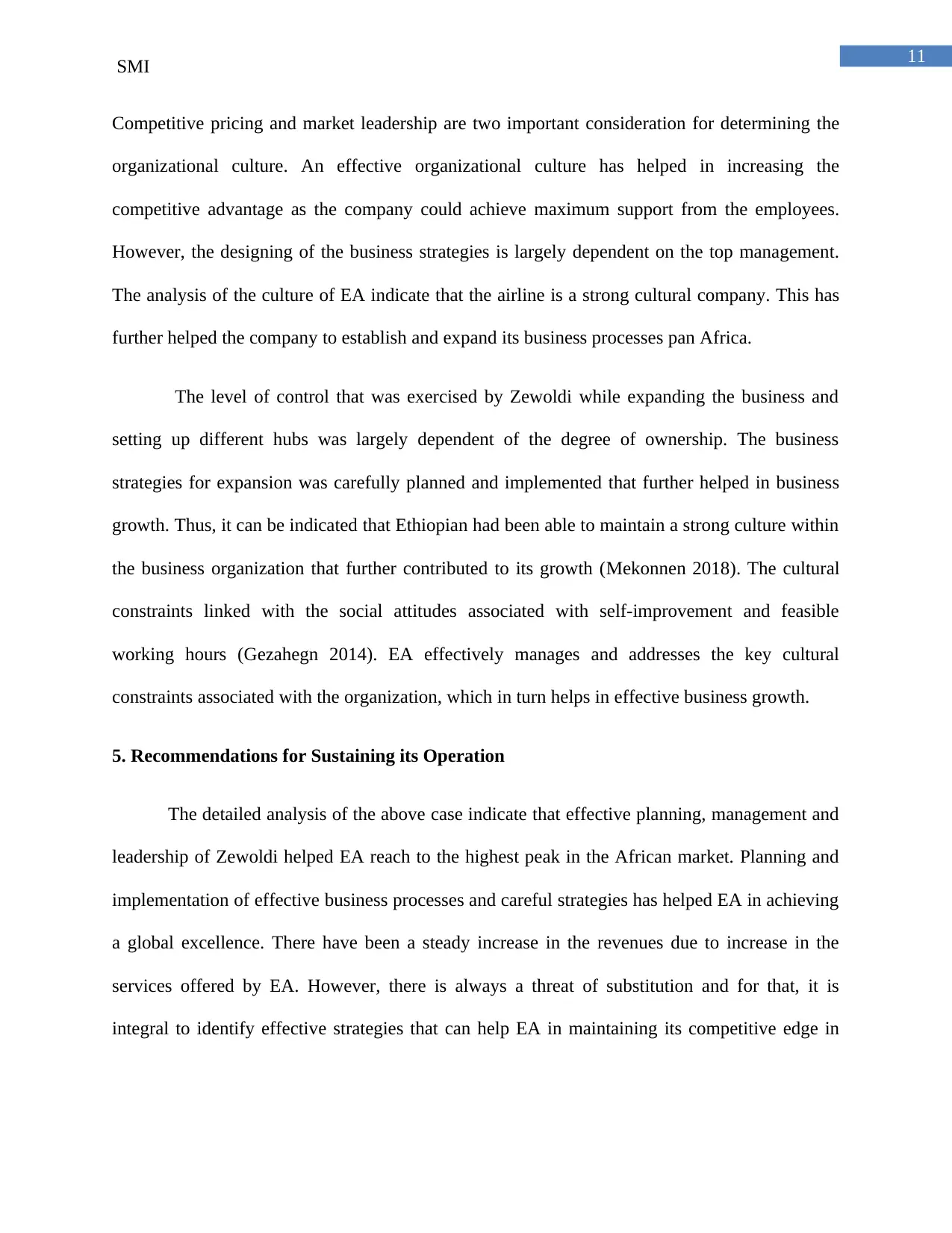
11
SMI
Competitive pricing and market leadership are two important consideration for determining the
organizational culture. An effective organizational culture has helped in increasing the
competitive advantage as the company could achieve maximum support from the employees.
However, the designing of the business strategies is largely dependent on the top management.
The analysis of the culture of EA indicate that the airline is a strong cultural company. This has
further helped the company to establish and expand its business processes pan Africa.
The level of control that was exercised by Zewoldi while expanding the business and
setting up different hubs was largely dependent of the degree of ownership. The business
strategies for expansion was carefully planned and implemented that further helped in business
growth. Thus, it can be indicated that Ethiopian had been able to maintain a strong culture within
the business organization that further contributed to its growth (Mekonnen 2018). The cultural
constraints linked with the social attitudes associated with self-improvement and feasible
working hours (Gezahegn 2014). EA effectively manages and addresses the key cultural
constraints associated with the organization, which in turn helps in effective business growth.
5. Recommendations for Sustaining its Operation
The detailed analysis of the above case indicate that effective planning, management and
leadership of Zewoldi helped EA reach to the highest peak in the African market. Planning and
implementation of effective business processes and careful strategies has helped EA in achieving
a global excellence. There have been a steady increase in the revenues due to increase in the
services offered by EA. However, there is always a threat of substitution and for that, it is
integral to identify effective strategies that can help EA in maintaining its competitive edge in
SMI
Competitive pricing and market leadership are two important consideration for determining the
organizational culture. An effective organizational culture has helped in increasing the
competitive advantage as the company could achieve maximum support from the employees.
However, the designing of the business strategies is largely dependent on the top management.
The analysis of the culture of EA indicate that the airline is a strong cultural company. This has
further helped the company to establish and expand its business processes pan Africa.
The level of control that was exercised by Zewoldi while expanding the business and
setting up different hubs was largely dependent of the degree of ownership. The business
strategies for expansion was carefully planned and implemented that further helped in business
growth. Thus, it can be indicated that Ethiopian had been able to maintain a strong culture within
the business organization that further contributed to its growth (Mekonnen 2018). The cultural
constraints linked with the social attitudes associated with self-improvement and feasible
working hours (Gezahegn 2014). EA effectively manages and addresses the key cultural
constraints associated with the organization, which in turn helps in effective business growth.
5. Recommendations for Sustaining its Operation
The detailed analysis of the above case indicate that effective planning, management and
leadership of Zewoldi helped EA reach to the highest peak in the African market. Planning and
implementation of effective business processes and careful strategies has helped EA in achieving
a global excellence. There have been a steady increase in the revenues due to increase in the
services offered by EA. However, there is always a threat of substitution and for that, it is
integral to identify effective strategies that can help EA in maintaining its competitive edge in
⊘ This is a preview!⊘
Do you want full access?
Subscribe today to unlock all pages.

Trusted by 1+ million students worldwide
1 out of 17
Related Documents
Your All-in-One AI-Powered Toolkit for Academic Success.
+13062052269
info@desklib.com
Available 24*7 on WhatsApp / Email
![[object Object]](/_next/static/media/star-bottom.7253800d.svg)
Unlock your academic potential
Copyright © 2020–2025 A2Z Services. All Rights Reserved. Developed and managed by ZUCOL.





